Cultural Safety in Healthcare: Needs and Australian Models
VerifiedAdded on 2022/10/11
|11
|2878
|13
Essay
AI Summary
This essay delves into the crucial concept of cultural safety in healthcare, emphasizing its significance in providing patient-centered care. It examines how cultural beliefs, traditions, and practices influence individuals' understanding of health and their expectations when seeking healthcare services. The essay analyzes three distinct cultural safety needs, highlighting their differences from Australian healthcare models, systems, guidelines, and policies. It also explores how registered nurses can respond to these differences to deliver culturally safe healthcare, including a specific focus on the cultural needs of Aboriginal and Torres Strait Islander people. The analysis covers the role of families in decision-making, religious beliefs surrounding life and death, and cultural perspectives on medications and pain relievers. The essay stresses the importance of respecting cultural diversity, building trust, and tailoring healthcare approaches to meet the unique needs of each patient. It aims to guide healthcare professionals in providing holistic and culturally sensitive care that aligns with patients' values and beliefs, ultimately promoting improved health outcomes and patient satisfaction.
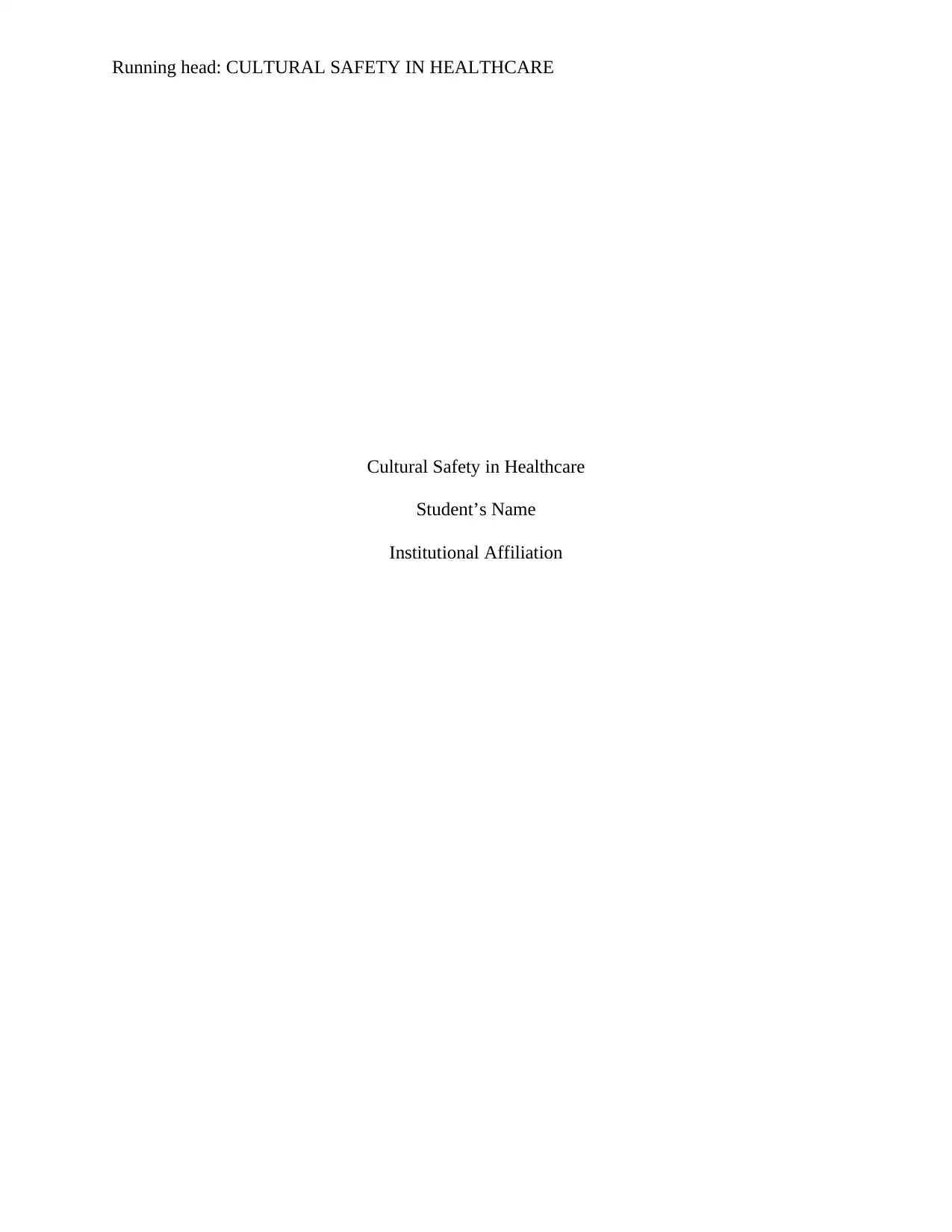
Running head: CULTURAL SAFETY IN HEALTHCARE
Cultural Safety in Healthcare
Student’s Name
Institutional Affiliation
Cultural Safety in Healthcare
Student’s Name
Institutional Affiliation
Paraphrase This Document
Need a fresh take? Get an instant paraphrase of this document with our AI Paraphraser
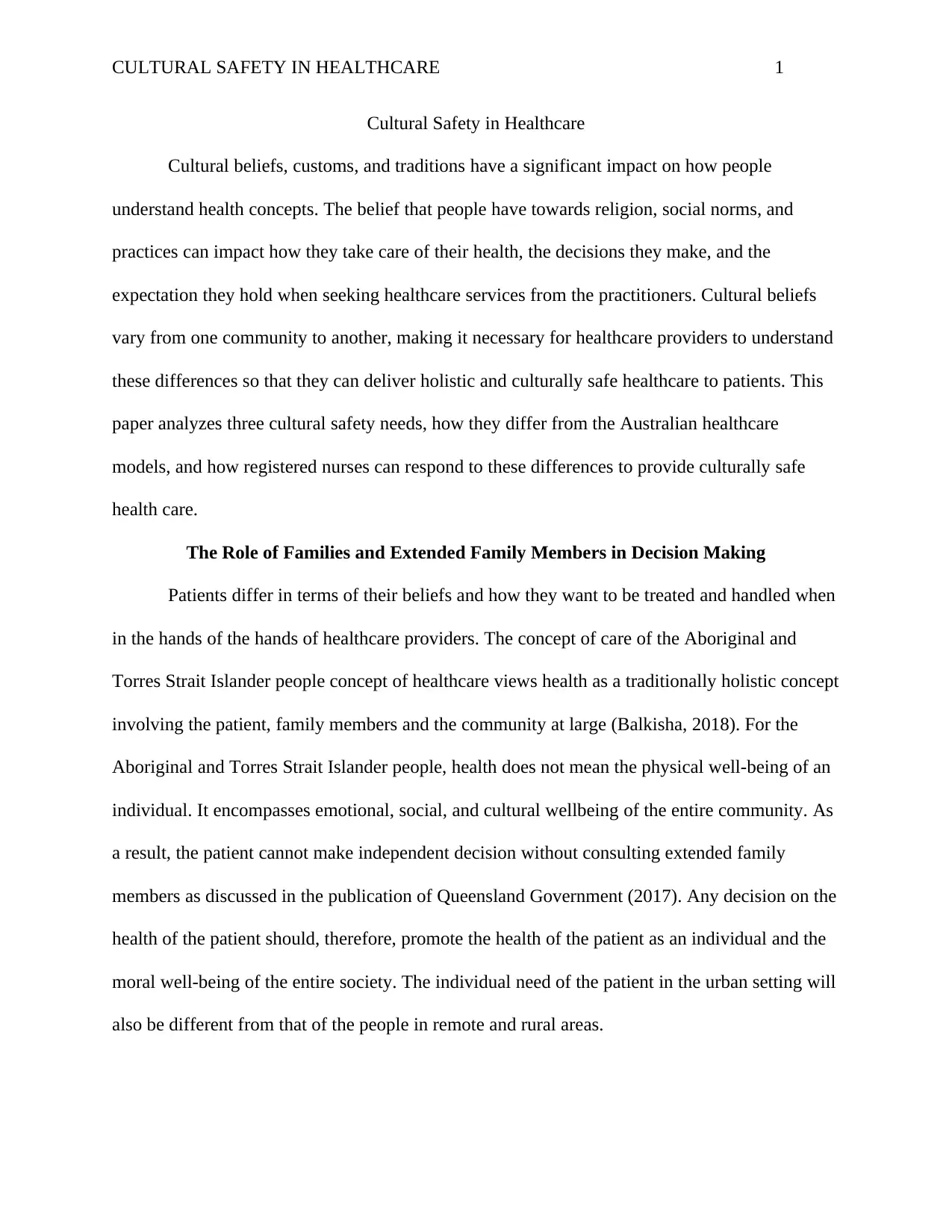
CULTURAL SAFETY IN HEALTHCARE 1
Cultural Safety in Healthcare
Cultural beliefs, customs, and traditions have a significant impact on how people
understand health concepts. The belief that people have towards religion, social norms, and
practices can impact how they take care of their health, the decisions they make, and the
expectation they hold when seeking healthcare services from the practitioners. Cultural beliefs
vary from one community to another, making it necessary for healthcare providers to understand
these differences so that they can deliver holistic and culturally safe healthcare to patients. This
paper analyzes three cultural safety needs, how they differ from the Australian healthcare
models, and how registered nurses can respond to these differences to provide culturally safe
health care.
The Role of Families and Extended Family Members in Decision Making
Patients differ in terms of their beliefs and how they want to be treated and handled when
in the hands of the hands of healthcare providers. The concept of care of the Aboriginal and
Torres Strait Islander people concept of healthcare views health as a traditionally holistic concept
involving the patient, family members and the community at large (Balkisha, 2018). For the
Aboriginal and Torres Strait Islander people, health does not mean the physical well-being of an
individual. It encompasses emotional, social, and cultural wellbeing of the entire community. As
a result, the patient cannot make independent decision without consulting extended family
members as discussed in the publication of Queensland Government (2017). Any decision on the
health of the patient should, therefore, promote the health of the patient as an individual and the
moral well-being of the entire society. The individual need of the patient in the urban setting will
also be different from that of the people in remote and rural areas.
Cultural Safety in Healthcare
Cultural beliefs, customs, and traditions have a significant impact on how people
understand health concepts. The belief that people have towards religion, social norms, and
practices can impact how they take care of their health, the decisions they make, and the
expectation they hold when seeking healthcare services from the practitioners. Cultural beliefs
vary from one community to another, making it necessary for healthcare providers to understand
these differences so that they can deliver holistic and culturally safe healthcare to patients. This
paper analyzes three cultural safety needs, how they differ from the Australian healthcare
models, and how registered nurses can respond to these differences to provide culturally safe
health care.
The Role of Families and Extended Family Members in Decision Making
Patients differ in terms of their beliefs and how they want to be treated and handled when
in the hands of the hands of healthcare providers. The concept of care of the Aboriginal and
Torres Strait Islander people concept of healthcare views health as a traditionally holistic concept
involving the patient, family members and the community at large (Balkisha, 2018). For the
Aboriginal and Torres Strait Islander people, health does not mean the physical well-being of an
individual. It encompasses emotional, social, and cultural wellbeing of the entire community. As
a result, the patient cannot make independent decision without consulting extended family
members as discussed in the publication of Queensland Government (2017). Any decision on the
health of the patient should, therefore, promote the health of the patient as an individual and the
moral well-being of the entire society. The individual need of the patient in the urban setting will
also be different from that of the people in remote and rural areas.
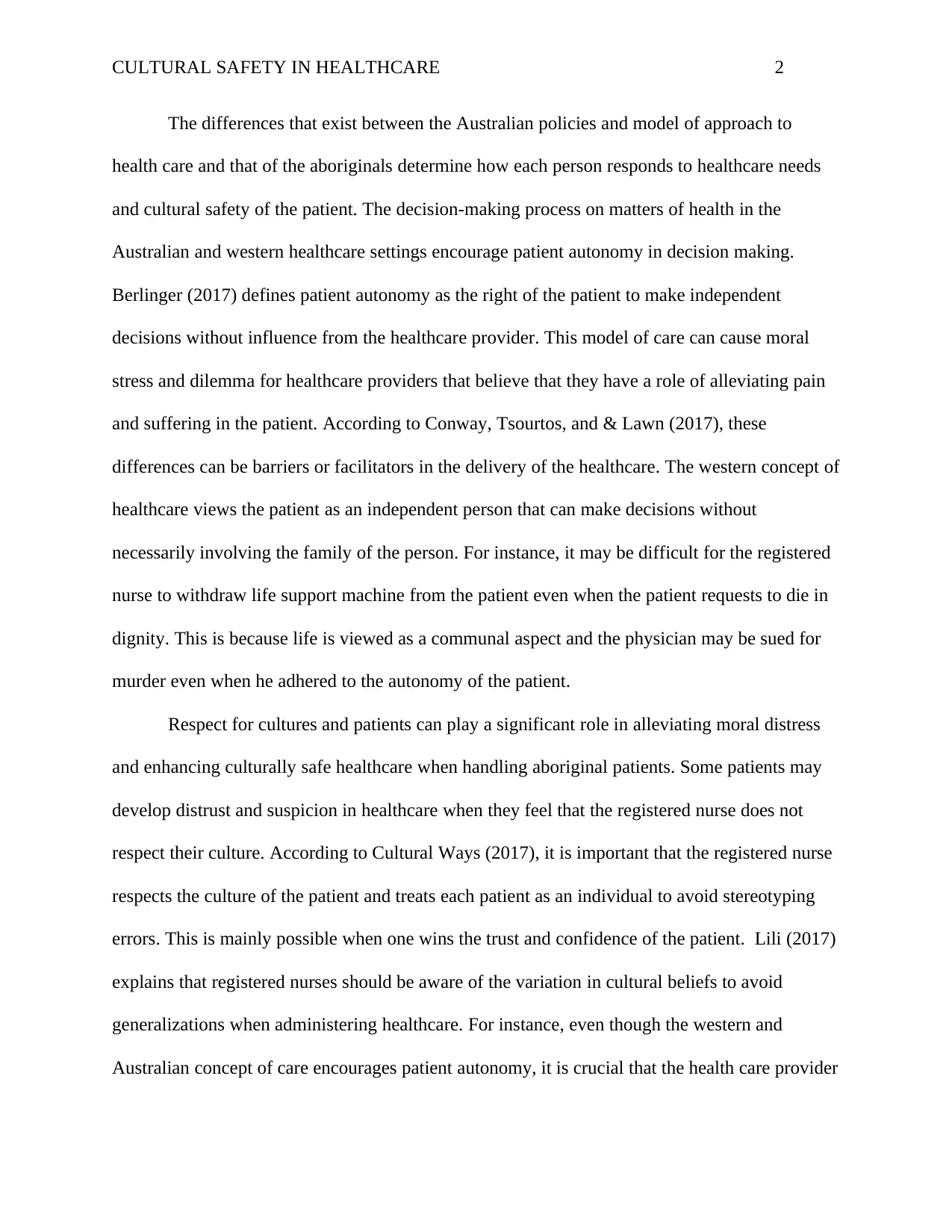
CULTURAL SAFETY IN HEALTHCARE 2
The differences that exist between the Australian policies and model of approach to
health care and that of the aboriginals determine how each person responds to healthcare needs
and cultural safety of the patient. The decision-making process on matters of health in the
Australian and western healthcare settings encourage patient autonomy in decision making.
Berlinger (2017) defines patient autonomy as the right of the patient to make independent
decisions without influence from the healthcare provider. This model of care can cause moral
stress and dilemma for healthcare providers that believe that they have a role of alleviating pain
and suffering in the patient. According to Conway, Tsourtos, and & Lawn (2017), these
differences can be barriers or facilitators in the delivery of the healthcare. The western concept of
healthcare views the patient as an independent person that can make decisions without
necessarily involving the family of the person. For instance, it may be difficult for the registered
nurse to withdraw life support machine from the patient even when the patient requests to die in
dignity. This is because life is viewed as a communal aspect and the physician may be sued for
murder even when he adhered to the autonomy of the patient.
Respect for cultures and patients can play a significant role in alleviating moral distress
and enhancing culturally safe healthcare when handling aboriginal patients. Some patients may
develop distrust and suspicion in healthcare when they feel that the registered nurse does not
respect their culture. According to Cultural Ways (2017), it is important that the registered nurse
respects the culture of the patient and treats each patient as an individual to avoid stereotyping
errors. This is mainly possible when one wins the trust and confidence of the patient. Lili (2017)
explains that registered nurses should be aware of the variation in cultural beliefs to avoid
generalizations when administering healthcare. For instance, even though the western and
Australian concept of care encourages patient autonomy, it is crucial that the health care provider
The differences that exist between the Australian policies and model of approach to
health care and that of the aboriginals determine how each person responds to healthcare needs
and cultural safety of the patient. The decision-making process on matters of health in the
Australian and western healthcare settings encourage patient autonomy in decision making.
Berlinger (2017) defines patient autonomy as the right of the patient to make independent
decisions without influence from the healthcare provider. This model of care can cause moral
stress and dilemma for healthcare providers that believe that they have a role of alleviating pain
and suffering in the patient. According to Conway, Tsourtos, and & Lawn (2017), these
differences can be barriers or facilitators in the delivery of the healthcare. The western concept of
healthcare views the patient as an independent person that can make decisions without
necessarily involving the family of the person. For instance, it may be difficult for the registered
nurse to withdraw life support machine from the patient even when the patient requests to die in
dignity. This is because life is viewed as a communal aspect and the physician may be sued for
murder even when he adhered to the autonomy of the patient.
Respect for cultures and patients can play a significant role in alleviating moral distress
and enhancing culturally safe healthcare when handling aboriginal patients. Some patients may
develop distrust and suspicion in healthcare when they feel that the registered nurse does not
respect their culture. According to Cultural Ways (2017), it is important that the registered nurse
respects the culture of the patient and treats each patient as an individual to avoid stereotyping
errors. This is mainly possible when one wins the trust and confidence of the patient. Lili (2017)
explains that registered nurses should be aware of the variation in cultural beliefs to avoid
generalizations when administering healthcare. For instance, even though the western and
Australian concept of care encourages patient autonomy, it is crucial that the health care provider
⊘ This is a preview!⊘
Do you want full access?
Subscribe today to unlock all pages.

Trusted by 1+ million students worldwide
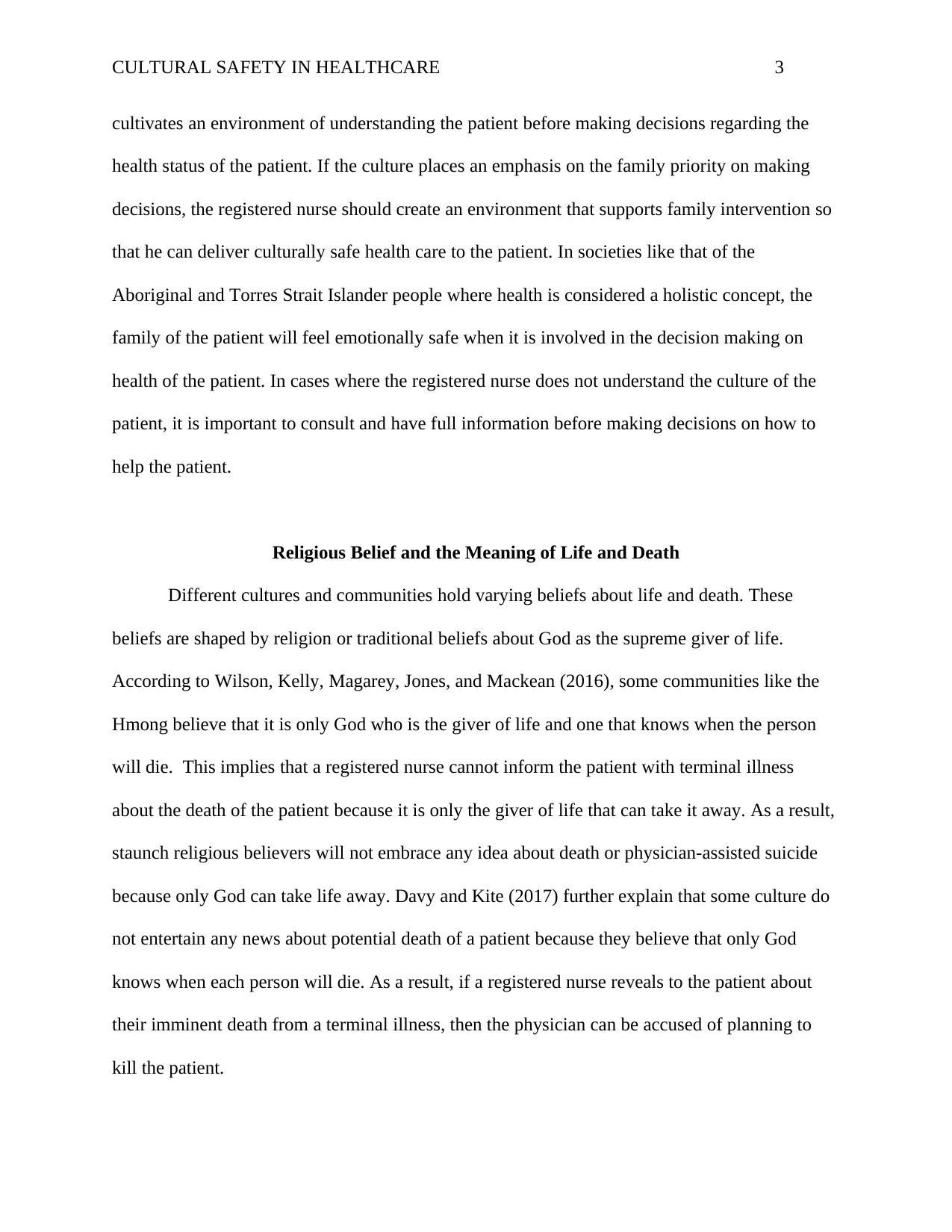
CULTURAL SAFETY IN HEALTHCARE 3
cultivates an environment of understanding the patient before making decisions regarding the
health status of the patient. If the culture places an emphasis on the family priority on making
decisions, the registered nurse should create an environment that supports family intervention so
that he can deliver culturally safe health care to the patient. In societies like that of the
Aboriginal and Torres Strait Islander people where health is considered a holistic concept, the
family of the patient will feel emotionally safe when it is involved in the decision making on
health of the patient. In cases where the registered nurse does not understand the culture of the
patient, it is important to consult and have full information before making decisions on how to
help the patient.
Religious Belief and the Meaning of Life and Death
Different cultures and communities hold varying beliefs about life and death. These
beliefs are shaped by religion or traditional beliefs about God as the supreme giver of life.
According to Wilson, Kelly, Magarey, Jones, and Mackean (2016), some communities like the
Hmong believe that it is only God who is the giver of life and one that knows when the person
will die. This implies that a registered nurse cannot inform the patient with terminal illness
about the death of the patient because it is only the giver of life that can take it away. As a result,
staunch religious believers will not embrace any idea about death or physician-assisted suicide
because only God can take life away. Davy and Kite (2017) further explain that some culture do
not entertain any news about potential death of a patient because they believe that only God
knows when each person will die. As a result, if a registered nurse reveals to the patient about
their imminent death from a terminal illness, then the physician can be accused of planning to
kill the patient.
cultivates an environment of understanding the patient before making decisions regarding the
health status of the patient. If the culture places an emphasis on the family priority on making
decisions, the registered nurse should create an environment that supports family intervention so
that he can deliver culturally safe health care to the patient. In societies like that of the
Aboriginal and Torres Strait Islander people where health is considered a holistic concept, the
family of the patient will feel emotionally safe when it is involved in the decision making on
health of the patient. In cases where the registered nurse does not understand the culture of the
patient, it is important to consult and have full information before making decisions on how to
help the patient.
Religious Belief and the Meaning of Life and Death
Different cultures and communities hold varying beliefs about life and death. These
beliefs are shaped by religion or traditional beliefs about God as the supreme giver of life.
According to Wilson, Kelly, Magarey, Jones, and Mackean (2016), some communities like the
Hmong believe that it is only God who is the giver of life and one that knows when the person
will die. This implies that a registered nurse cannot inform the patient with terminal illness
about the death of the patient because it is only the giver of life that can take it away. As a result,
staunch religious believers will not embrace any idea about death or physician-assisted suicide
because only God can take life away. Davy and Kite (2017) further explain that some culture do
not entertain any news about potential death of a patient because they believe that only God
knows when each person will die. As a result, if a registered nurse reveals to the patient about
their imminent death from a terminal illness, then the physician can be accused of planning to
kill the patient.
Paraphrase This Document
Need a fresh take? Get an instant paraphrase of this document with our AI Paraphraser
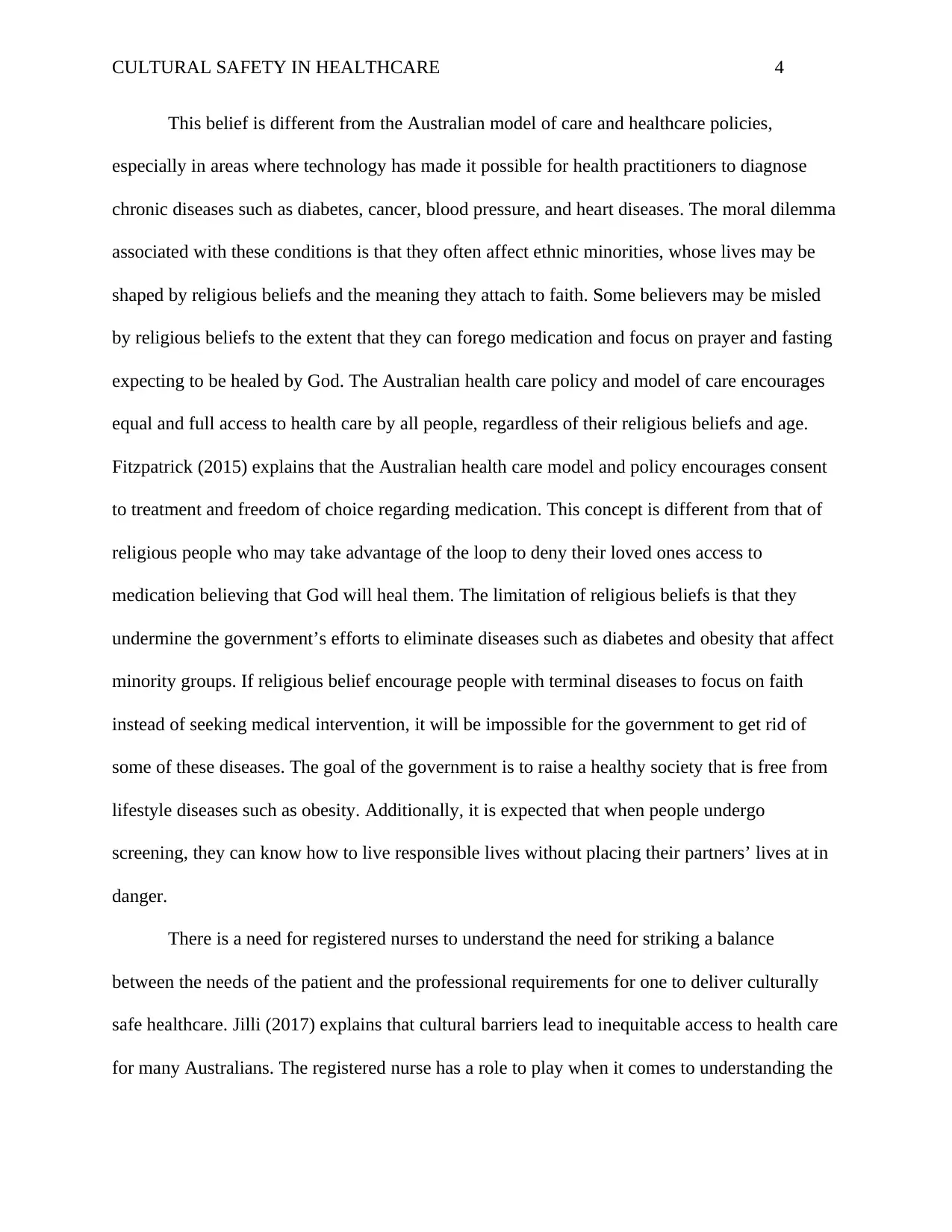
CULTURAL SAFETY IN HEALTHCARE 4
This belief is different from the Australian model of care and healthcare policies,
especially in areas where technology has made it possible for health practitioners to diagnose
chronic diseases such as diabetes, cancer, blood pressure, and heart diseases. The moral dilemma
associated with these conditions is that they often affect ethnic minorities, whose lives may be
shaped by religious beliefs and the meaning they attach to faith. Some believers may be misled
by religious beliefs to the extent that they can forego medication and focus on prayer and fasting
expecting to be healed by God. The Australian health care policy and model of care encourages
equal and full access to health care by all people, regardless of their religious beliefs and age.
Fitzpatrick (2015) explains that the Australian health care model and policy encourages consent
to treatment and freedom of choice regarding medication. This concept is different from that of
religious people who may take advantage of the loop to deny their loved ones access to
medication believing that God will heal them. The limitation of religious beliefs is that they
undermine the government’s efforts to eliminate diseases such as diabetes and obesity that affect
minority groups. If religious belief encourage people with terminal diseases to focus on faith
instead of seeking medical intervention, it will be impossible for the government to get rid of
some of these diseases. The goal of the government is to raise a healthy society that is free from
lifestyle diseases such as obesity. Additionally, it is expected that when people undergo
screening, they can know how to live responsible lives without placing their partners’ lives at in
danger.
There is a need for registered nurses to understand the need for striking a balance
between the needs of the patient and the professional requirements for one to deliver culturally
safe healthcare. Jilli (2017) explains that cultural barriers lead to inequitable access to health care
for many Australians. The registered nurse has a role to play when it comes to understanding the
This belief is different from the Australian model of care and healthcare policies,
especially in areas where technology has made it possible for health practitioners to diagnose
chronic diseases such as diabetes, cancer, blood pressure, and heart diseases. The moral dilemma
associated with these conditions is that they often affect ethnic minorities, whose lives may be
shaped by religious beliefs and the meaning they attach to faith. Some believers may be misled
by religious beliefs to the extent that they can forego medication and focus on prayer and fasting
expecting to be healed by God. The Australian health care policy and model of care encourages
equal and full access to health care by all people, regardless of their religious beliefs and age.
Fitzpatrick (2015) explains that the Australian health care model and policy encourages consent
to treatment and freedom of choice regarding medication. This concept is different from that of
religious people who may take advantage of the loop to deny their loved ones access to
medication believing that God will heal them. The limitation of religious beliefs is that they
undermine the government’s efforts to eliminate diseases such as diabetes and obesity that affect
minority groups. If religious belief encourage people with terminal diseases to focus on faith
instead of seeking medical intervention, it will be impossible for the government to get rid of
some of these diseases. The goal of the government is to raise a healthy society that is free from
lifestyle diseases such as obesity. Additionally, it is expected that when people undergo
screening, they can know how to live responsible lives without placing their partners’ lives at in
danger.
There is a need for registered nurses to understand the need for striking a balance
between the needs of the patient and the professional requirements for one to deliver culturally
safe healthcare. Jilli (2017) explains that cultural barriers lead to inequitable access to health care
for many Australians. The registered nurse has a role to play when it comes to understanding the
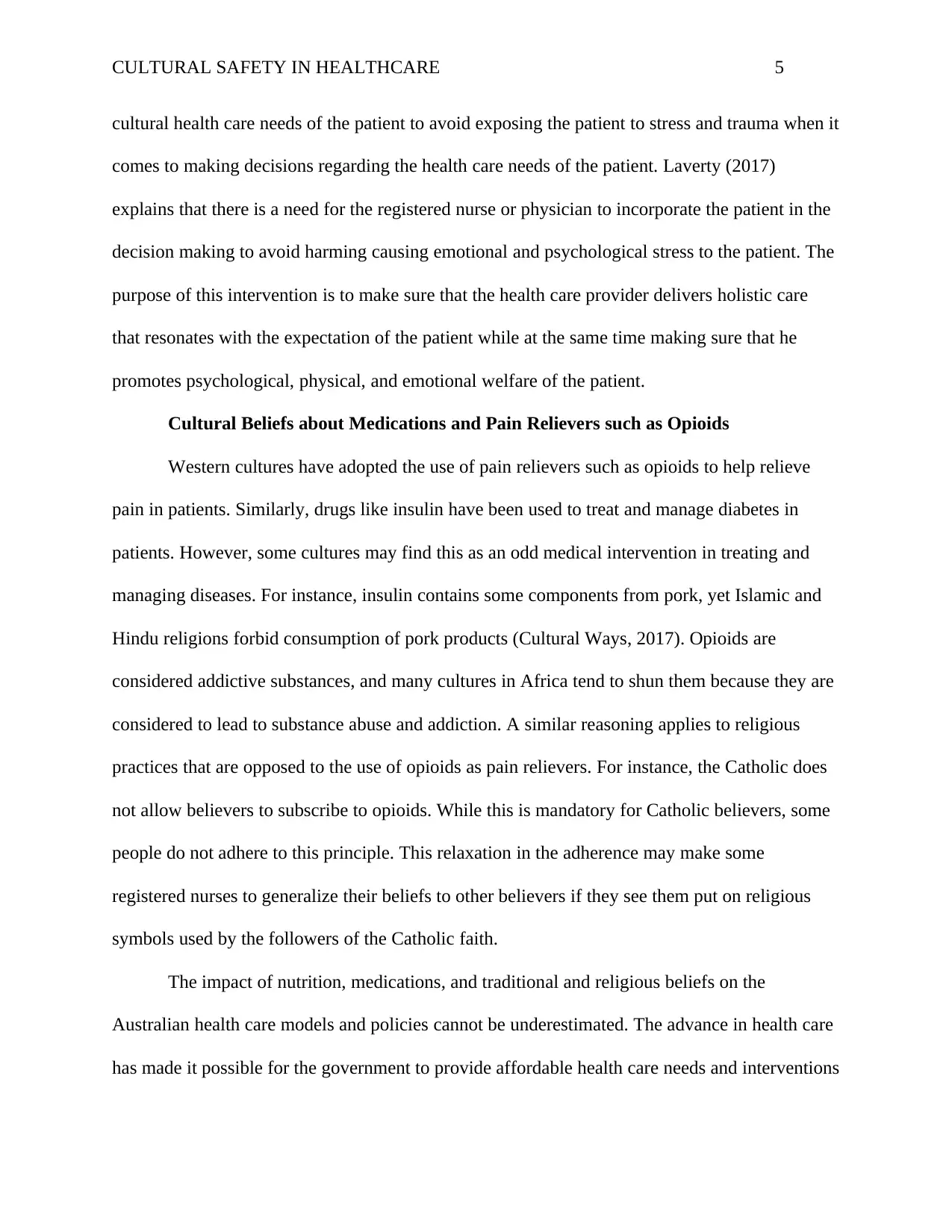
CULTURAL SAFETY IN HEALTHCARE 5
cultural health care needs of the patient to avoid exposing the patient to stress and trauma when it
comes to making decisions regarding the health care needs of the patient. Laverty (2017)
explains that there is a need for the registered nurse or physician to incorporate the patient in the
decision making to avoid harming causing emotional and psychological stress to the patient. The
purpose of this intervention is to make sure that the health care provider delivers holistic care
that resonates with the expectation of the patient while at the same time making sure that he
promotes psychological, physical, and emotional welfare of the patient.
Cultural Beliefs about Medications and Pain Relievers such as Opioids
Western cultures have adopted the use of pain relievers such as opioids to help relieve
pain in patients. Similarly, drugs like insulin have been used to treat and manage diabetes in
patients. However, some cultures may find this as an odd medical intervention in treating and
managing diseases. For instance, insulin contains some components from pork, yet Islamic and
Hindu religions forbid consumption of pork products (Cultural Ways, 2017). Opioids are
considered addictive substances, and many cultures in Africa tend to shun them because they are
considered to lead to substance abuse and addiction. A similar reasoning applies to religious
practices that are opposed to the use of opioids as pain relievers. For instance, the Catholic does
not allow believers to subscribe to opioids. While this is mandatory for Catholic believers, some
people do not adhere to this principle. This relaxation in the adherence may make some
registered nurses to generalize their beliefs to other believers if they see them put on religious
symbols used by the followers of the Catholic faith.
The impact of nutrition, medications, and traditional and religious beliefs on the
Australian health care models and policies cannot be underestimated. The advance in health care
has made it possible for the government to provide affordable health care needs and interventions
cultural health care needs of the patient to avoid exposing the patient to stress and trauma when it
comes to making decisions regarding the health care needs of the patient. Laverty (2017)
explains that there is a need for the registered nurse or physician to incorporate the patient in the
decision making to avoid harming causing emotional and psychological stress to the patient. The
purpose of this intervention is to make sure that the health care provider delivers holistic care
that resonates with the expectation of the patient while at the same time making sure that he
promotes psychological, physical, and emotional welfare of the patient.
Cultural Beliefs about Medications and Pain Relievers such as Opioids
Western cultures have adopted the use of pain relievers such as opioids to help relieve
pain in patients. Similarly, drugs like insulin have been used to treat and manage diabetes in
patients. However, some cultures may find this as an odd medical intervention in treating and
managing diseases. For instance, insulin contains some components from pork, yet Islamic and
Hindu religions forbid consumption of pork products (Cultural Ways, 2017). Opioids are
considered addictive substances, and many cultures in Africa tend to shun them because they are
considered to lead to substance abuse and addiction. A similar reasoning applies to religious
practices that are opposed to the use of opioids as pain relievers. For instance, the Catholic does
not allow believers to subscribe to opioids. While this is mandatory for Catholic believers, some
people do not adhere to this principle. This relaxation in the adherence may make some
registered nurses to generalize their beliefs to other believers if they see them put on religious
symbols used by the followers of the Catholic faith.
The impact of nutrition, medications, and traditional and religious beliefs on the
Australian health care models and policies cannot be underestimated. The advance in health care
has made it possible for the government to provide affordable health care needs and interventions
⊘ This is a preview!⊘
Do you want full access?
Subscribe today to unlock all pages.

Trusted by 1+ million students worldwide
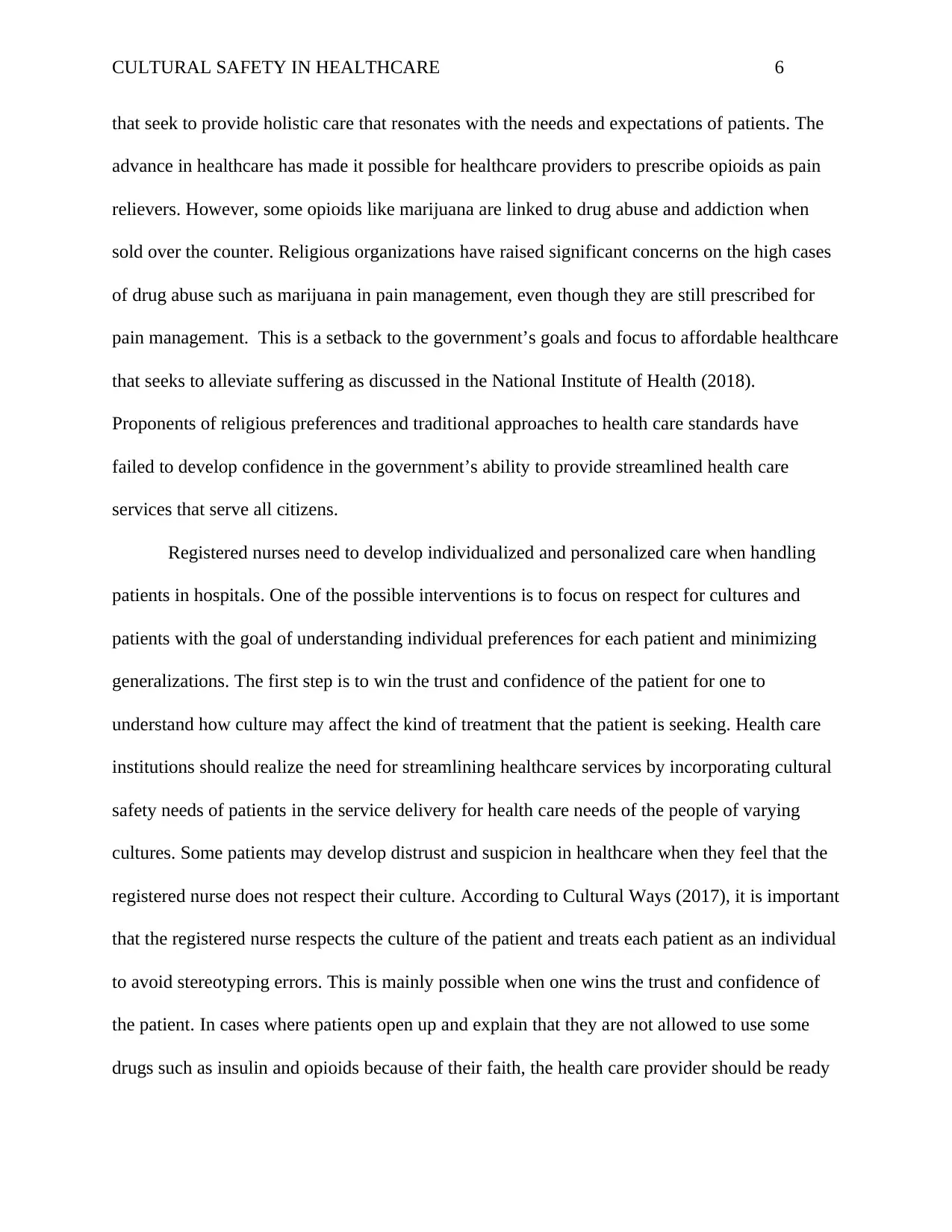
CULTURAL SAFETY IN HEALTHCARE 6
that seek to provide holistic care that resonates with the needs and expectations of patients. The
advance in healthcare has made it possible for healthcare providers to prescribe opioids as pain
relievers. However, some opioids like marijuana are linked to drug abuse and addiction when
sold over the counter. Religious organizations have raised significant concerns on the high cases
of drug abuse such as marijuana in pain management, even though they are still prescribed for
pain management. This is a setback to the government’s goals and focus to affordable healthcare
that seeks to alleviate suffering as discussed in the National Institute of Health (2018).
Proponents of religious preferences and traditional approaches to health care standards have
failed to develop confidence in the government’s ability to provide streamlined health care
services that serve all citizens.
Registered nurses need to develop individualized and personalized care when handling
patients in hospitals. One of the possible interventions is to focus on respect for cultures and
patients with the goal of understanding individual preferences for each patient and minimizing
generalizations. The first step is to win the trust and confidence of the patient for one to
understand how culture may affect the kind of treatment that the patient is seeking. Health care
institutions should realize the need for streamlining healthcare services by incorporating cultural
safety needs of patients in the service delivery for health care needs of the people of varying
cultures. Some patients may develop distrust and suspicion in healthcare when they feel that the
registered nurse does not respect their culture. According to Cultural Ways (2017), it is important
that the registered nurse respects the culture of the patient and treats each patient as an individual
to avoid stereotyping errors. This is mainly possible when one wins the trust and confidence of
the patient. In cases where patients open up and explain that they are not allowed to use some
drugs such as insulin and opioids because of their faith, the health care provider should be ready
that seek to provide holistic care that resonates with the needs and expectations of patients. The
advance in healthcare has made it possible for healthcare providers to prescribe opioids as pain
relievers. However, some opioids like marijuana are linked to drug abuse and addiction when
sold over the counter. Religious organizations have raised significant concerns on the high cases
of drug abuse such as marijuana in pain management, even though they are still prescribed for
pain management. This is a setback to the government’s goals and focus to affordable healthcare
that seeks to alleviate suffering as discussed in the National Institute of Health (2018).
Proponents of religious preferences and traditional approaches to health care standards have
failed to develop confidence in the government’s ability to provide streamlined health care
services that serve all citizens.
Registered nurses need to develop individualized and personalized care when handling
patients in hospitals. One of the possible interventions is to focus on respect for cultures and
patients with the goal of understanding individual preferences for each patient and minimizing
generalizations. The first step is to win the trust and confidence of the patient for one to
understand how culture may affect the kind of treatment that the patient is seeking. Health care
institutions should realize the need for streamlining healthcare services by incorporating cultural
safety needs of patients in the service delivery for health care needs of the people of varying
cultures. Some patients may develop distrust and suspicion in healthcare when they feel that the
registered nurse does not respect their culture. According to Cultural Ways (2017), it is important
that the registered nurse respects the culture of the patient and treats each patient as an individual
to avoid stereotyping errors. This is mainly possible when one wins the trust and confidence of
the patient. In cases where patients open up and explain that they are not allowed to use some
drugs such as insulin and opioids because of their faith, the health care provider should be ready
Paraphrase This Document
Need a fresh take? Get an instant paraphrase of this document with our AI Paraphraser
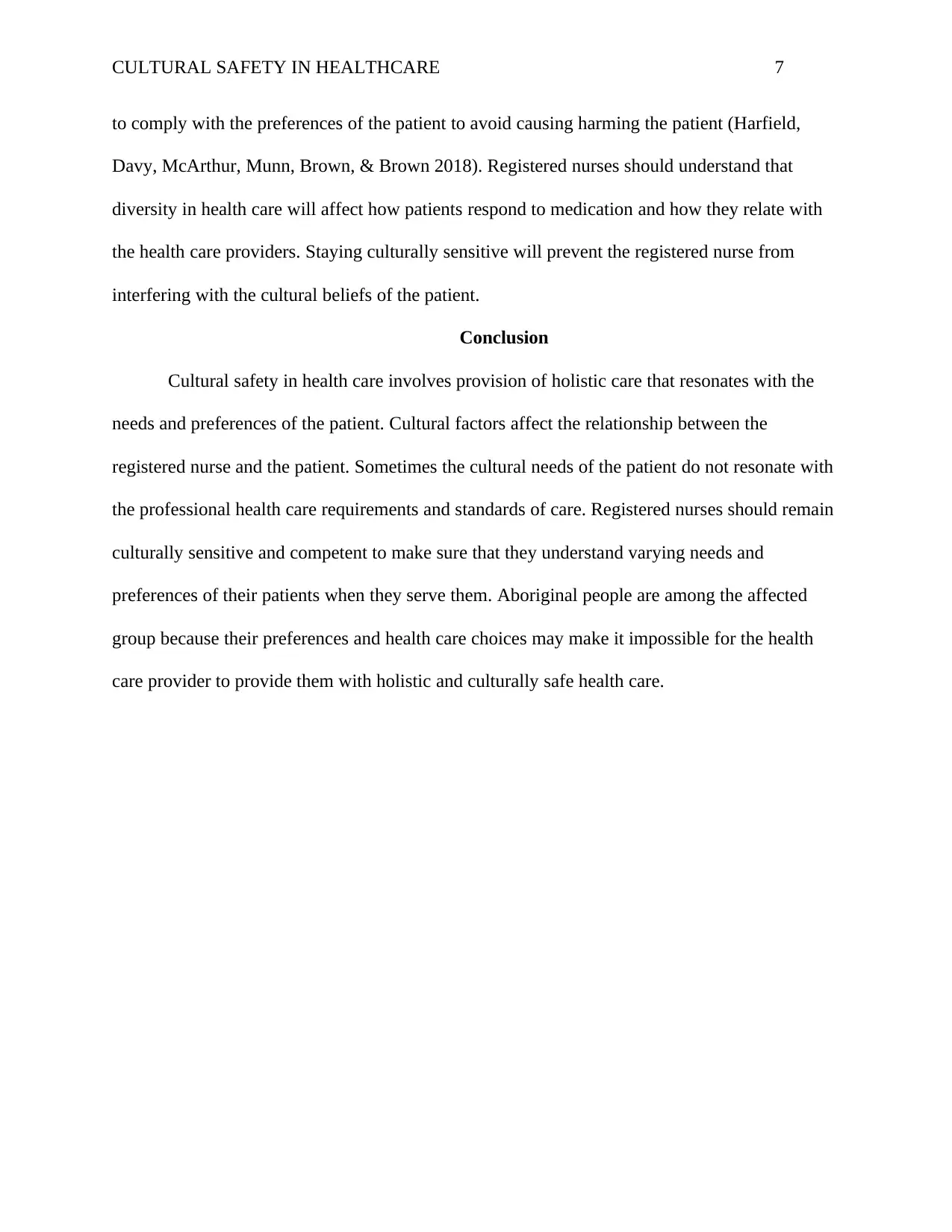
CULTURAL SAFETY IN HEALTHCARE 7
to comply with the preferences of the patient to avoid causing harming the patient (Harfield,
Davy, McArthur, Munn, Brown, & Brown 2018). Registered nurses should understand that
diversity in health care will affect how patients respond to medication and how they relate with
the health care providers. Staying culturally sensitive will prevent the registered nurse from
interfering with the cultural beliefs of the patient.
Conclusion
Cultural safety in health care involves provision of holistic care that resonates with the
needs and preferences of the patient. Cultural factors affect the relationship between the
registered nurse and the patient. Sometimes the cultural needs of the patient do not resonate with
the professional health care requirements and standards of care. Registered nurses should remain
culturally sensitive and competent to make sure that they understand varying needs and
preferences of their patients when they serve them. Aboriginal people are among the affected
group because their preferences and health care choices may make it impossible for the health
care provider to provide them with holistic and culturally safe health care.
to comply with the preferences of the patient to avoid causing harming the patient (Harfield,
Davy, McArthur, Munn, Brown, & Brown 2018). Registered nurses should understand that
diversity in health care will affect how patients respond to medication and how they relate with
the health care providers. Staying culturally sensitive will prevent the registered nurse from
interfering with the cultural beliefs of the patient.
Conclusion
Cultural safety in health care involves provision of holistic care that resonates with the
needs and preferences of the patient. Cultural factors affect the relationship between the
registered nurse and the patient. Sometimes the cultural needs of the patient do not resonate with
the professional health care requirements and standards of care. Registered nurses should remain
culturally sensitive and competent to make sure that they understand varying needs and
preferences of their patients when they serve them. Aboriginal people are among the affected
group because their preferences and health care choices may make it impossible for the health
care provider to provide them with holistic and culturally safe health care.
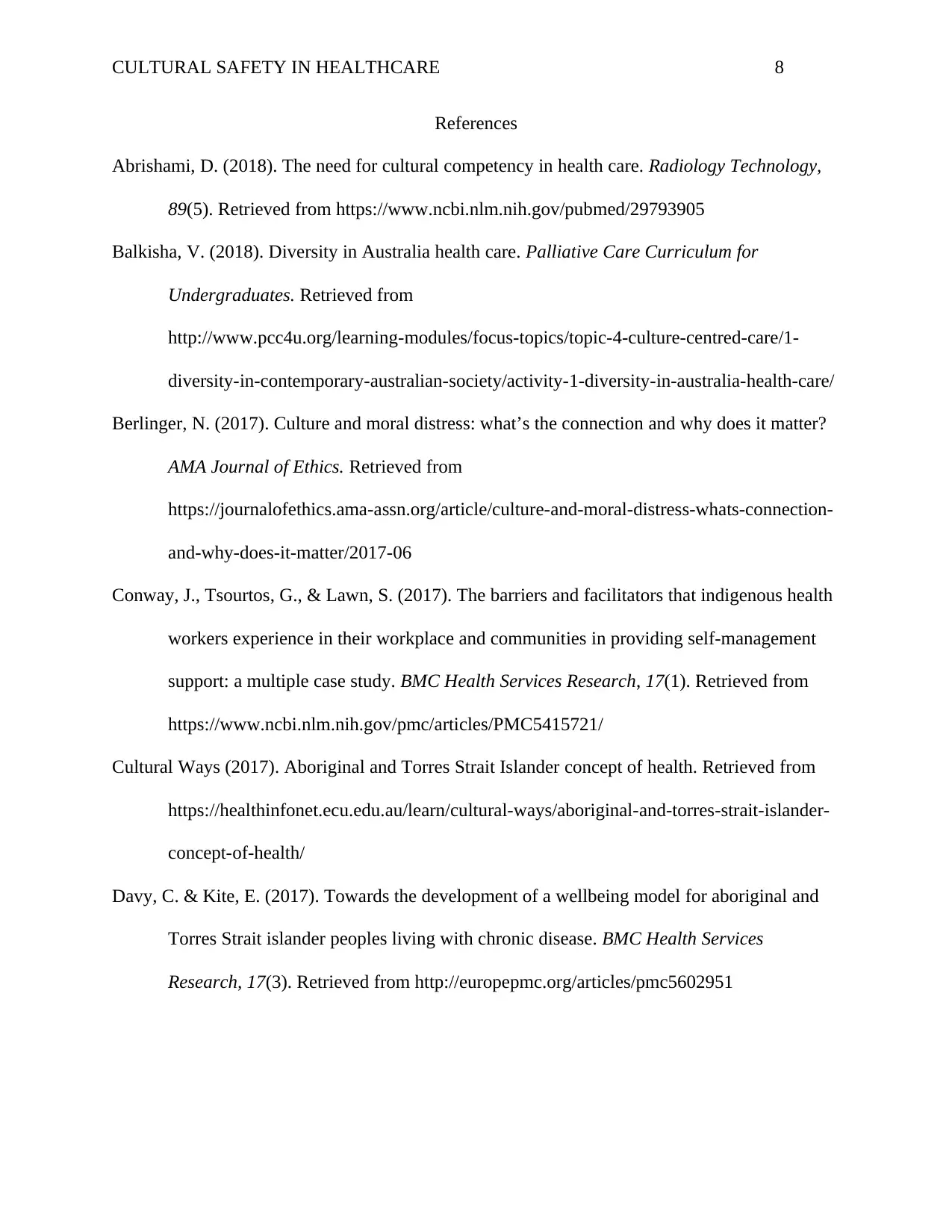
CULTURAL SAFETY IN HEALTHCARE 8
References
Abrishami, D. (2018). The need for cultural competency in health care. Radiology Technology,
89(5). Retrieved from https://www.ncbi.nlm.nih.gov/pubmed/29793905
Balkisha, V. (2018). Diversity in Australia health care. Palliative Care Curriculum for
Undergraduates. Retrieved from
http://www.pcc4u.org/learning-modules/focus-topics/topic-4-culture-centred-care/1-
diversity-in-contemporary-australian-society/activity-1-diversity-in-australia-health-care/
Berlinger, N. (2017). Culture and moral distress: what’s the connection and why does it matter?
AMA Journal of Ethics. Retrieved from
https://journalofethics.ama-assn.org/article/culture-and-moral-distress-whats-connection-
and-why-does-it-matter/2017-06
Conway, J., Tsourtos, G., & Lawn, S. (2017). The barriers and facilitators that indigenous health
workers experience in their workplace and communities in providing self-management
support: a multiple case study. BMC Health Services Research, 17(1). Retrieved from
https://www.ncbi.nlm.nih.gov/pmc/articles/PMC5415721/
Cultural Ways (2017). Aboriginal and Torres Strait Islander concept of health. Retrieved from
https://healthinfonet.ecu.edu.au/learn/cultural-ways/aboriginal-and-torres-strait-islander-
concept-of-health/
Davy, C. & Kite, E. (2017). Towards the development of a wellbeing model for aboriginal and
Torres Strait islander peoples living with chronic disease. BMC Health Services
Research, 17(3). Retrieved from http://europepmc.org/articles/pmc5602951
References
Abrishami, D. (2018). The need for cultural competency in health care. Radiology Technology,
89(5). Retrieved from https://www.ncbi.nlm.nih.gov/pubmed/29793905
Balkisha, V. (2018). Diversity in Australia health care. Palliative Care Curriculum for
Undergraduates. Retrieved from
http://www.pcc4u.org/learning-modules/focus-topics/topic-4-culture-centred-care/1-
diversity-in-contemporary-australian-society/activity-1-diversity-in-australia-health-care/
Berlinger, N. (2017). Culture and moral distress: what’s the connection and why does it matter?
AMA Journal of Ethics. Retrieved from
https://journalofethics.ama-assn.org/article/culture-and-moral-distress-whats-connection-
and-why-does-it-matter/2017-06
Conway, J., Tsourtos, G., & Lawn, S. (2017). The barriers and facilitators that indigenous health
workers experience in their workplace and communities in providing self-management
support: a multiple case study. BMC Health Services Research, 17(1). Retrieved from
https://www.ncbi.nlm.nih.gov/pmc/articles/PMC5415721/
Cultural Ways (2017). Aboriginal and Torres Strait Islander concept of health. Retrieved from
https://healthinfonet.ecu.edu.au/learn/cultural-ways/aboriginal-and-torres-strait-islander-
concept-of-health/
Davy, C. & Kite, E. (2017). Towards the development of a wellbeing model for aboriginal and
Torres Strait islander peoples living with chronic disease. BMC Health Services
Research, 17(3). Retrieved from http://europepmc.org/articles/pmc5602951
⊘ This is a preview!⊘
Do you want full access?
Subscribe today to unlock all pages.

Trusted by 1+ million students worldwide
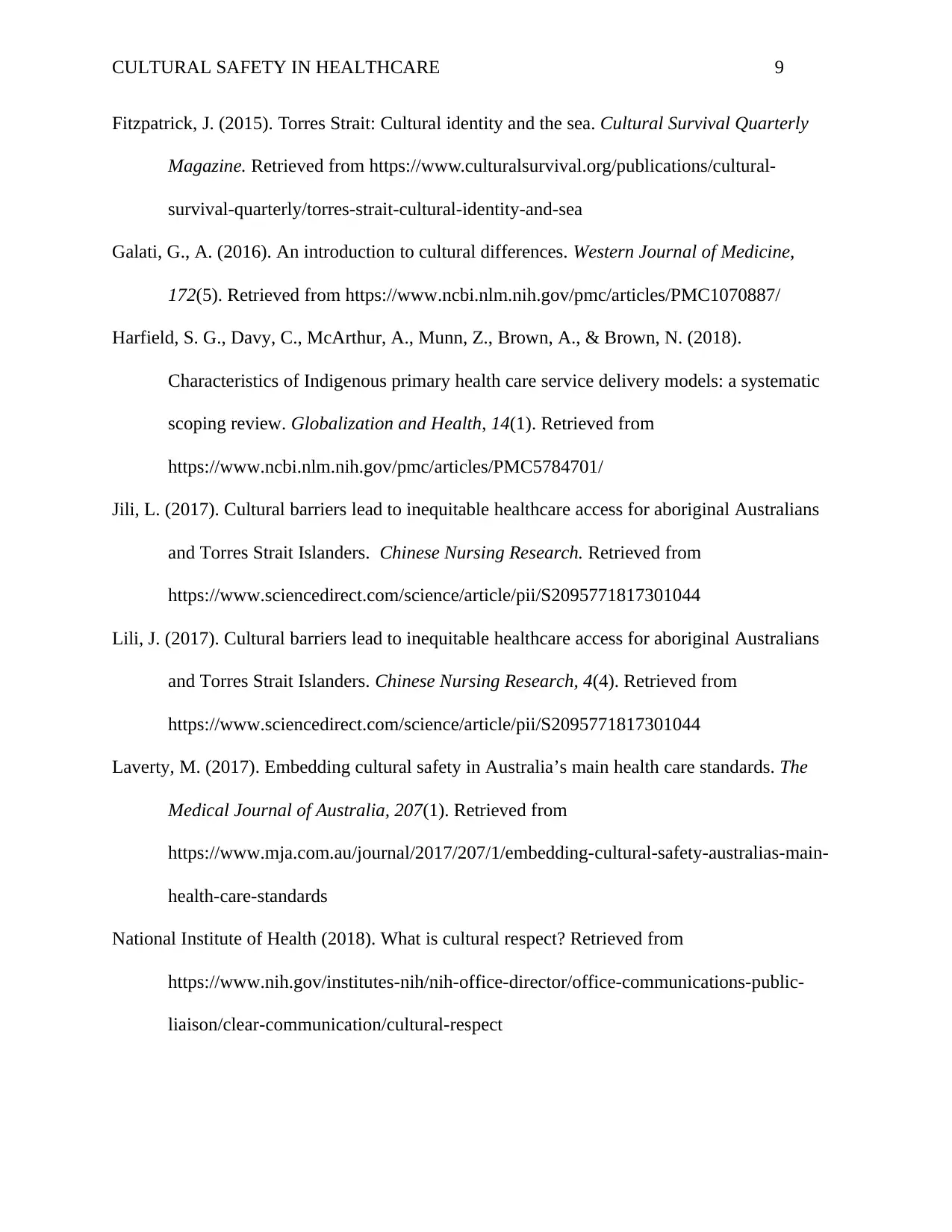
CULTURAL SAFETY IN HEALTHCARE 9
Fitzpatrick, J. (2015). Torres Strait: Cultural identity and the sea. Cultural Survival Quarterly
Magazine. Retrieved from https://www.culturalsurvival.org/publications/cultural-
survival-quarterly/torres-strait-cultural-identity-and-sea
Galati, G., A. (2016). An introduction to cultural differences. Western Journal of Medicine,
172(5). Retrieved from https://www.ncbi.nlm.nih.gov/pmc/articles/PMC1070887/
Harfield, S. G., Davy, C., McArthur, A., Munn, Z., Brown, A., & Brown, N. (2018).
Characteristics of Indigenous primary health care service delivery models: a systematic
scoping review. Globalization and Health, 14(1). Retrieved from
https://www.ncbi.nlm.nih.gov/pmc/articles/PMC5784701/
Jili, L. (2017). Cultural barriers lead to inequitable healthcare access for aboriginal Australians
and Torres Strait Islanders. Chinese Nursing Research. Retrieved from
https://www.sciencedirect.com/science/article/pii/S2095771817301044
Lili, J. (2017). Cultural barriers lead to inequitable healthcare access for aboriginal Australians
and Torres Strait Islanders. Chinese Nursing Research, 4(4). Retrieved from
https://www.sciencedirect.com/science/article/pii/S2095771817301044
Laverty, M. (2017). Embedding cultural safety in Australia’s main health care standards. The
Medical Journal of Australia, 207(1). Retrieved from
https://www.mja.com.au/journal/2017/207/1/embedding-cultural-safety-australias-main-
health-care-standards
National Institute of Health (2018). What is cultural respect? Retrieved from
https://www.nih.gov/institutes-nih/nih-office-director/office-communications-public-
liaison/clear-communication/cultural-respect
Fitzpatrick, J. (2015). Torres Strait: Cultural identity and the sea. Cultural Survival Quarterly
Magazine. Retrieved from https://www.culturalsurvival.org/publications/cultural-
survival-quarterly/torres-strait-cultural-identity-and-sea
Galati, G., A. (2016). An introduction to cultural differences. Western Journal of Medicine,
172(5). Retrieved from https://www.ncbi.nlm.nih.gov/pmc/articles/PMC1070887/
Harfield, S. G., Davy, C., McArthur, A., Munn, Z., Brown, A., & Brown, N. (2018).
Characteristics of Indigenous primary health care service delivery models: a systematic
scoping review. Globalization and Health, 14(1). Retrieved from
https://www.ncbi.nlm.nih.gov/pmc/articles/PMC5784701/
Jili, L. (2017). Cultural barriers lead to inequitable healthcare access for aboriginal Australians
and Torres Strait Islanders. Chinese Nursing Research. Retrieved from
https://www.sciencedirect.com/science/article/pii/S2095771817301044
Lili, J. (2017). Cultural barriers lead to inequitable healthcare access for aboriginal Australians
and Torres Strait Islanders. Chinese Nursing Research, 4(4). Retrieved from
https://www.sciencedirect.com/science/article/pii/S2095771817301044
Laverty, M. (2017). Embedding cultural safety in Australia’s main health care standards. The
Medical Journal of Australia, 207(1). Retrieved from
https://www.mja.com.au/journal/2017/207/1/embedding-cultural-safety-australias-main-
health-care-standards
National Institute of Health (2018). What is cultural respect? Retrieved from
https://www.nih.gov/institutes-nih/nih-office-director/office-communications-public-
liaison/clear-communication/cultural-respect
Paraphrase This Document
Need a fresh take? Get an instant paraphrase of this document with our AI Paraphraser
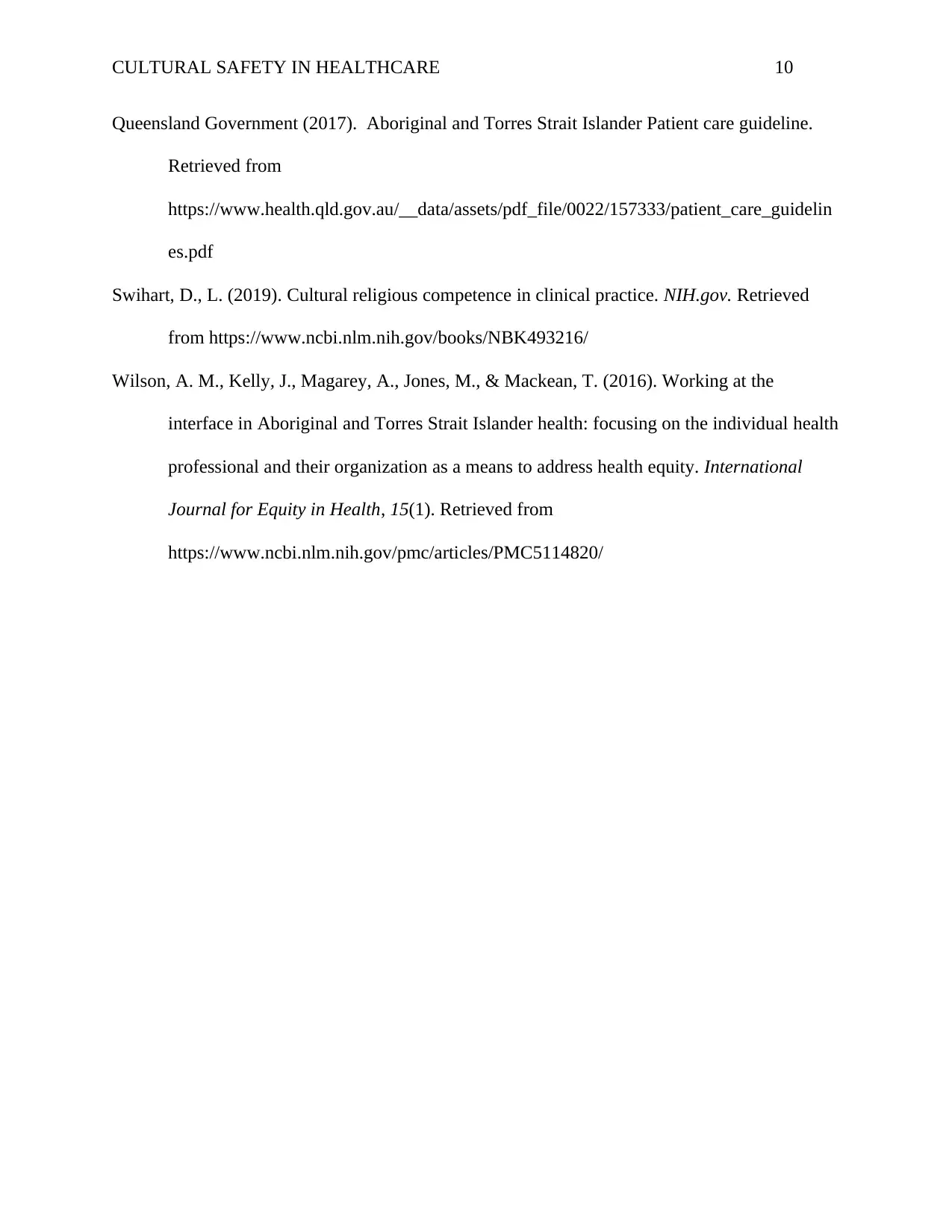
CULTURAL SAFETY IN HEALTHCARE 10
Queensland Government (2017). Aboriginal and Torres Strait Islander Patient care guideline.
Retrieved from
https://www.health.qld.gov.au/__data/assets/pdf_file/0022/157333/patient_care_guidelin
es.pdf
Swihart, D., L. (2019). Cultural religious competence in clinical practice. NIH.gov. Retrieved
from https://www.ncbi.nlm.nih.gov/books/NBK493216/
Wilson, A. M., Kelly, J., Magarey, A., Jones, M., & Mackean, T. (2016). Working at the
interface in Aboriginal and Torres Strait Islander health: focusing on the individual health
professional and their organization as a means to address health equity. International
Journal for Equity in Health, 15(1). Retrieved from
https://www.ncbi.nlm.nih.gov/pmc/articles/PMC5114820/
Queensland Government (2017). Aboriginal and Torres Strait Islander Patient care guideline.
Retrieved from
https://www.health.qld.gov.au/__data/assets/pdf_file/0022/157333/patient_care_guidelin
es.pdf
Swihart, D., L. (2019). Cultural religious competence in clinical practice. NIH.gov. Retrieved
from https://www.ncbi.nlm.nih.gov/books/NBK493216/
Wilson, A. M., Kelly, J., Magarey, A., Jones, M., & Mackean, T. (2016). Working at the
interface in Aboriginal and Torres Strait Islander health: focusing on the individual health
professional and their organization as a means to address health equity. International
Journal for Equity in Health, 15(1). Retrieved from
https://www.ncbi.nlm.nih.gov/pmc/articles/PMC5114820/
1 out of 11
Related Documents
Your All-in-One AI-Powered Toolkit for Academic Success.
+13062052269
info@desklib.com
Available 24*7 on WhatsApp / Email
![[object Object]](/_next/static/media/star-bottom.7253800d.svg)
Unlock your academic potential
Copyright © 2020–2025 A2Z Services. All Rights Reserved. Developed and managed by ZUCOL.





